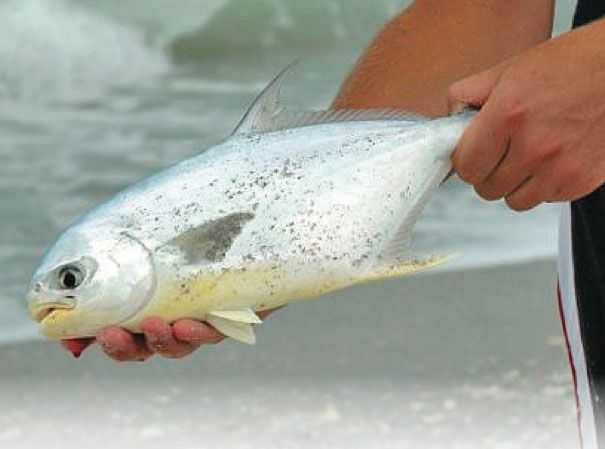I have always considered surf fishing to be the best of both worlds – you get to enjoy fun in the sun at the beach while you also have a shot at catching some really nice fish, one of which is the Florida pompano (Trachinotus carolinus). Most of the time you don’t even need to buy bait because one of the best baits, sand fleas, can be caught right on the beach.
One of the most sought after and elusive surf fish on our coast is the Florida pompano. This spectacularly silvery member of the jack family is well known for powerful runs as it can strip drag off a spinning reel while in only a few feet of water. Very skillful in utilizing the beach’s currents and crashing waves to their advantage, pompano use their flattened side of the body to push against the water. Hook one up on light spinning tackle and hold on. If you are lucky and skillful enough to catch one, then you will also find they provide some of the finest table fare among all the fish in the sea.
Florida pompano are schooling fish commonly found in coastal waters from Massachusetts to southeastern Brazil. Though usually weighing in at 1 or 2 pounds, the Florida pompano can grow to 8 pounds and 25 inches. Most spawning takes place in late Winter and Spring. Identifying Florida pompano can sometimes be tricky. The most common misidentification is with the permit (Trachinotus falcatus), which can grow to over 40 pounds and is deeper bodied, and the palometa (Trachinotus goodei) which is smaller, has longer dorsal and anal fins, and thin vertical bars on its sides. For a positive ID, if the fish is over 8 pounds and 25 inches then it’s a permit. If it’s less than that size then press the body just under the pectoral fin with your thumb – if you feel a large, thick rib just under the skin, then it’s a permit. Pompano are usually yellowish on the underside while permit are usually orange. Keep in mind, however that one can not completely rely on color in identifying fish.
Researchers have found that Florida pompano can be found along Florida’s beaches year round, moving north and south as they follow the 15° C isotherm. This means tha when the coastal waters in an area hit around 59° F, then it’s time to go pompano fishing. Live sand fleas are one of the best baits for Florida pompano. Sand fleas are actually not fleas at all, as their scientifically accepted name is the mole crab (Emerita talpoida). They are decapods and are closely related to other crabs, lobsters, and shrimp. These craft y little creatures live their adult lives in the swash zone on beaches. Adapted antennae filter water for food particles as each wave crashes on the beach. Look for V-shaped patterns in the sand at the water’s edge to locate groups of mole crabs digging in the sand. To catch them, use your hands or get high-tech and use a sand fl ea rake which can be fashioned out of wire mesh or bought at most bait shops. Rigging for pompano on Florida’s beaches can vary greatly depending upon the water clarity, wave action, and current.
Along the Gulf Coast many anglers use jigs or even wet flies. Along the East Coast, where waves and currents can be much more of a factor, take 3 to 4 feet of 30-pound monofilament, tie a swivel on the top which will connect to the mainline, tie two dropper loops for looping in the hooks, and tie a sinker on the bottom. The pre-made “tourist rigs” which are usually made of metal leader probably just scare more fish than anything else. It’s much cheaper to just make your own rigs. I prefer using Eagle Claw 2/0 circle hooks because they have extra large eyes perfect for looping in the line. Currents can vary so carry a good assortment of 1 to 4-ounce pyramid weights. Bait up with fresh sand fleas if you can catch’em, or use small, one inch long pieces of very fresh or live shrimp or clams, the fresher the better.
[easy-social-share]
